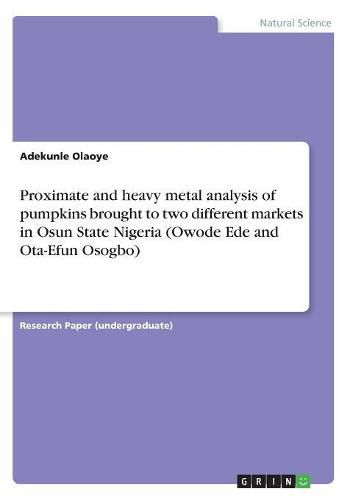Readings Newsletter
Become a Readings Member to make your shopping experience even easier.
Sign in or sign up for free!
You’re not far away from qualifying for FREE standard shipping within Australia
You’ve qualified for FREE standard shipping within Australia
The cart is loading…






Research Paper (undergraduate) from the year 2016 in the subject Biology - Miscellaneous, grade: 3.2, course: PURE AND APPLIED CHEMISTRY, language: English, abstract: Proximate and heavy metal analysis were carried out in the leaves of pumpkin bought in two different market in Osun State Nigeria (Owode Ede and Ota-Efun Osogbo). The result of the proximate analysis showed that the leaves contain: Moisture (2.88 % and 2.53%), Ash (14.45% and 13.90%), Crude Fibre (2.6 % and 2.3 %), Fat (13.20 % and 12.85%), Protein (25.66 % and 25.40 %) and Carbohydrate (41.21 % and 43.02 %) respectively for A and B. This shows that the pumpkin leaves could be used as food to supplement these nutrients. The result of heavy metal analysis using (AAS) analysis reveals that concentration of Zn (2.32 mg/g and 1.76 mg/g), Cu(1.55 mg/g and 1.05 mg/g), Fe (5.98 mg/g and 5.30 mg/g) and Mn (0.21 mg/g and 0.16 mg/g) for A and B respectively. Because of high concentration of Zn and Fe, it was concluded that pumpkin leaves could be a good source of energy and proteins for human and animals.
$9.00 standard shipping within Australia
FREE standard shipping within Australia for orders over $100.00
Express & International shipping calculated at checkout
Research Paper (undergraduate) from the year 2016 in the subject Biology - Miscellaneous, grade: 3.2, course: PURE AND APPLIED CHEMISTRY, language: English, abstract: Proximate and heavy metal analysis were carried out in the leaves of pumpkin bought in two different market in Osun State Nigeria (Owode Ede and Ota-Efun Osogbo). The result of the proximate analysis showed that the leaves contain: Moisture (2.88 % and 2.53%), Ash (14.45% and 13.90%), Crude Fibre (2.6 % and 2.3 %), Fat (13.20 % and 12.85%), Protein (25.66 % and 25.40 %) and Carbohydrate (41.21 % and 43.02 %) respectively for A and B. This shows that the pumpkin leaves could be used as food to supplement these nutrients. The result of heavy metal analysis using (AAS) analysis reveals that concentration of Zn (2.32 mg/g and 1.76 mg/g), Cu(1.55 mg/g and 1.05 mg/g), Fe (5.98 mg/g and 5.30 mg/g) and Mn (0.21 mg/g and 0.16 mg/g) for A and B respectively. Because of high concentration of Zn and Fe, it was concluded that pumpkin leaves could be a good source of energy and proteins for human and animals.